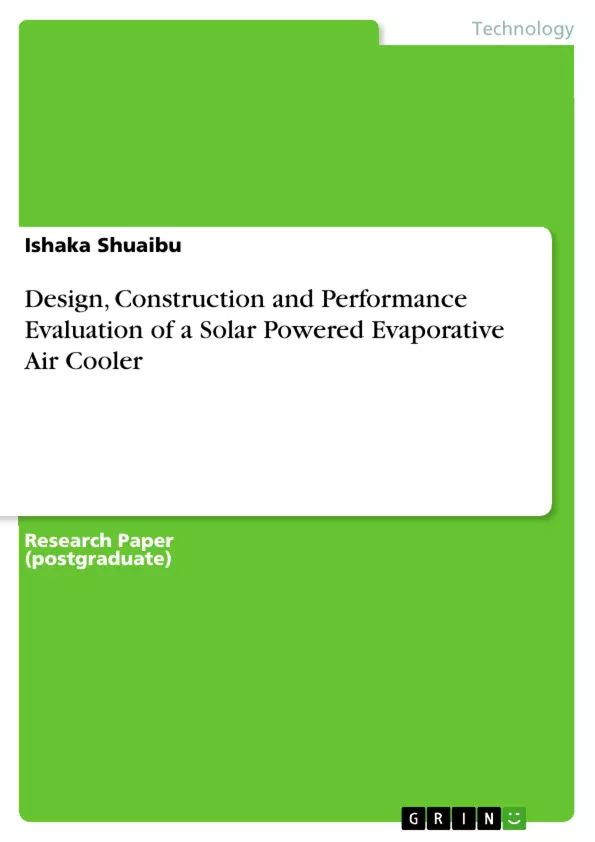Solar powered evaporative cooler using locally available materials such as galvanized iron, thin wooden strips, car radiator fan and submersible water pump of low power types was designed and constructed. Performance of this system was experimentally investigated while cooling a room space of approximately a volume of 43.5m3. This solar evaporative cooler was compared with 1.5hp air-condition (AC) system using six different configurations and encouraging results in terms of temperature reduction ranging from 4.6 ̊C-7.6 ̊C; relative humidity ranging from 24.0%-54.9% and cooling effectiveness ranging from 35.4%-97.3%were found. In this work humidity and temperature control unit was integrated to control water supply there by regulating the humidity level of the room space while cooling. Energy consumption of this air cooler for 6hrs was 0.054kWh while that of AC is 6.75kWh. This technology is cheaper and can efficiently improve indoor air quality and it is suitable for residential application especially for villages, schools and offices where there is a power outage problem or no grid extension.
Inhaltsverzeichnis (Table of Contents)
- 1.0 INTRODUCTION
- 12.0 MATERIALS AND METHODS
- Materials
- Methods
- Water Grills (Khas)
- Design/Sizing of the evaporative air cooler
- Air delivery or air displacement (V1)
- Heat load calculations
- Water tank volume determination
- Design for cover joint
- Design for fasteners (bolts and nuts)
- Components Selections
- Selection of suction fan
- Room volume
- Air volume per minute required
- Selection of water recirculation pump
- Selection of pipes (water channels)
- Selection of cooling pad
- Determination of energy requirement
- Selection of solar power supply system
- Module sizing
- Charge controller sizing
- Determination of battery capacity
Zielsetzung und Themenschwerpunkte (Objectives and Key Themes)
This research aims to design, construct, and evaluate the performance of a solar-powered evaporative air cooler using locally available materials. The goal is to provide an energy-efficient and cost-effective cooling solution, particularly for areas with power outages or limited grid access.
- Design and construction of a solar-powered evaporative air cooler
- Performance evaluation of the cooling system
- Energy consumption analysis and comparison to conventional air conditioning
- Utilization of locally sourced materials for sustainability and affordability
- Potential applications in residential, educational, and commercial settings
Zusammenfassung der Kapitel (Chapter Summaries)
- 1.0 INTRODUCTION: This chapter introduces the concept of evaporative cooling and its relevance as an energy-efficient alternative to conventional air conditioning. It highlights the challenges posed by fossil fuel dependence, climate change, and power instability. The chapter emphasizes the need for sustainable cooling solutions, particularly in regions with abundant solar radiation.
- 12.0 MATERIALS AND METHODS: This chapter details the materials used in the construction of the solar-powered evaporative air cooler, emphasizing the selection criteria such as local availability, cost-effectiveness, and environmental impact. The chapter outlines the methods employed in the design and construction process, including the selection of components like suction fans, water recirculation pumps, and cooling pads. It also explains the calculations involved in determining the optimal size and specifications of the system.
Schlüsselwörter (Keywords)
This work focuses on the design, construction, and performance evaluation of a solar-powered evaporative air cooler, utilizing locally sourced materials. Key concepts include energy efficiency, sustainable cooling, renewable energy sources, performance analysis, and energy consumption comparison. The research addresses the challenges of power instability and the need for alternative cooling solutions in various settings, particularly in regions with abundant solar radiation.
- Quote paper
- Ishaka Shuaibu (Author), 2018, Design, Construction and Performance Evaluation of a Solar Powered Evaporative Air Cooler, Munich, GRIN Verlag, https://www.grin.com/document/491211



